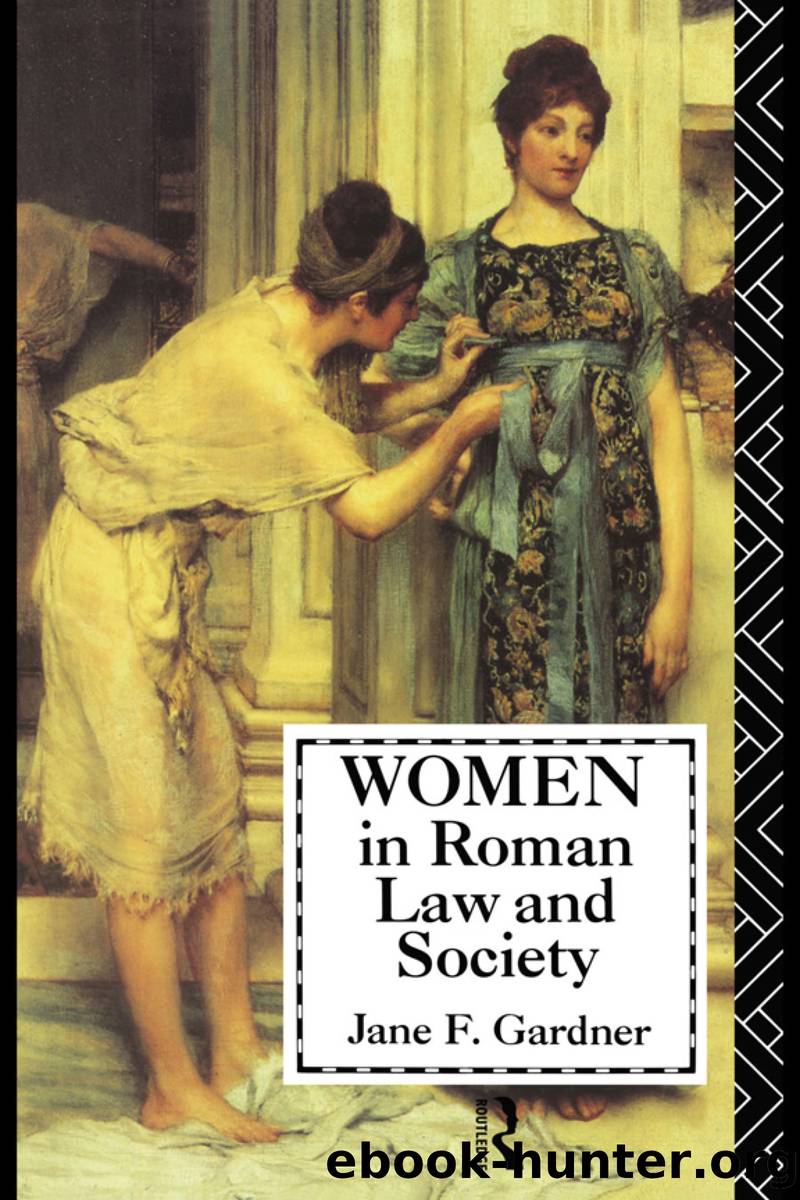Women in Roman Law and Society by Jane F. Gardner;

Author:Jane F. Gardner;
Language: eng
Format: epub
ISBN: 9781134930265
Publisher: Taylor & Francis (Unlimited)
Published: 2009-06-15T00:00:00+00:00
Birth Certificate
It was not compulsory at Rome to register the birth of a child. However, the Augustan lex Aelia Sentia and lex Papia Poppaea established a procedure for the registration of legitimate children of citizen status, to be carried out within 30 days of the childâs birth. It need not be made by the father; the mother or grandfather could doit.21
The declaration (professio) was made before a magistrate. The particulars were entered in the official record (tabula professionum) and the form is known to us from copies preserved on diptych tablets from Egypt containing a copy of the extract from the records. No independent check was made of the truth of the declarations, so the register provided only prima facie evidence. (The same is true of declarations of birth in modern England, although failure to declare is an offence.) The diptych copies start with the date, then a statement that this is a copy from the official register. The text of the entry follows, with reference by tabula and page number for the year in question. The details supplied were the fatherâs name, tribe and filiation, the childâs name, that of the mother, and the date.22
Several provisions of Augustan legislation made it important to be able to provide evidence of age and citizen-status, either for oneself or oneâs children, and also of the fact of having had legitimate children. The existence of one or more children increased their parentsâ capacity to receive inheritances from outsiders; the âprivilege of childrenâ (ius liberorum) freed women from tutela, and after the senatusconsultum Tertullianum, of Hadrianic date, it also gave them some rights of inheritance from their children (described in more detail in Chapter 9). Manumitters, under the lex Aelia Sentia, had to be over 20 years of age. Obviously, once birth registration became customary, it could be used for other purposes, e.g., to establish that one had reached marriageable age.
Registration of illegitimate children was forbidden under these laws; Augustus had been interested in encouraging procreation within lawful wedlock. Nevertheless, some illegitimate children had citizen status, and it could be important for them to be able to prove this in later life. The practice developed, therefore, of making private sworn declarations (testationes) before seven witnesses. One already cited, from Herculaneum, was made by a Junian Latin freedman, L.Venidius Ennychus. He declared the birth of a daughter and then, a year later, he attested that she was one year old, so that he and his wife could claim citizenship. In an example from Egypt, dated A.D. 131, a soldier attested the birth of a daughter, so staking her claim, under Hadrianâs ruling, to inherit from him. In A.D. 145 a woman, Sempronia Gemella, recorded the birth of twin sons (clearly, twins ran in her family) âof unknown fatherâ, incerto patre, with the filiation therefore given as Spurlif. According to Ulpian, one more child would get her the ius liberorum, though according to Paul three separate births were necessary, an alarming prospect, given her genetic inheritanceâand they had to be live births.
Download
This site does not store any files on its server. We only index and link to content provided by other sites. Please contact the content providers to delete copyright contents if any and email us, we'll remove relevant links or contents immediately.
| Central Africa | East Africa |
| North Africa | Southern Africa |
| West Africa | Algeria |
| Egypt | Ethiopia |
| Kenya | Nigeria |
| South Africa | Sudan |
| Zimbabwe |
Goodbye Paradise(2970)
Men at Arms by Terry Pratchett(2408)
Tobruk by Peter Fitzsimons(2064)
Pirate Alley by Terry McKnight(1910)
Arabs by Eugene Rogan(1837)
Borders by unknow(1789)
Belonging by Unknown(1472)
The Biafra Story by Frederick Forsyth(1325)
It's Our Turn to Eat by Michela Wrong(1305)
Botswana--Culture Smart! by Michael Main(1238)
A Winter in Arabia by Freya Stark(1225)
Gandhi by Ramachandra Guha(1196)
Coffee: From Bean to Barista by Robert W. Thurston(1182)
Livingstone by Tim Jeal(1152)
The Falls by Unknown(1142)
The Source by James A. Michener(1135)
The Shield and The Sword by Ernle Bradford(1101)
Egyptian Mythology A Fascinating Guide to Understanding the Gods, Goddesses, Monsters, and Mortals (Greek Mythology - Norse Mythology - Egyptian Mythology) by Matt Clayton(1088)
Africa: Altered States, Ordinary Miracles by Richard Dowden(1078)
